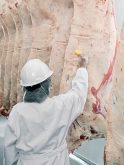Note: This column was written and went to print before the federal government announced that the Canadian Food Inspection Agency would allow a two-year transition period for the new livestock transportation regulations, as they apply to cattle.
The Canadian Food Inspection Agency will start phasing in its enforcement of Canada’s revised livestock transportation regulations on February 20. One of the most significant changes for cattle transporters is a reduction in the maximum time in transit before cattle must be off-loaded for feed, water and rest.
Read Also

Body condition, nutrition and vaccination for brood cows
One of the remarkable events of the past century related to ranching has been the genetic evolution of brood cows….
Currently, cattle can be transported for 48 hours before a mandatory five-hour feed, water and rest stop. There is one exception; if a truck is less than four hours from its final destination when it reaches the 48-hour mark, it can continue to its destination without a rest stop. On February 20, this changes to a maximum of 36 hours before an eight-hour feed, water and rest stop, with no four-hour grace period. This change will likely have the greatest impact on feeder cattle and truckers travelling from Western to Central Canada, and cattle travelling from Central to Western Canada for slaughter.
Canada’s National Farm Animal Care Council had an expert panel review the state of scientific knowledge and gaps pertaining to livestock transport in 2018. They reported that “there is currently a lack of information on the effectiveness of feed and water rest stops in mitigating the negative welfare, health and performance effects of long-distance transportation.” Most published cattle rest stop studies used stock trailers carrying 20 calves per load (Journal of Animal Science 91:5448-5454 and Journal of Animal Science 95:636-644) rather than large cattle liners with professional drivers. One study evaluated 129 commercial cattle liner loads that stopped at a Thunder Bay rest station, how long they stayed, animal loading density, and slips and falls during unloading, but not whether animals ate, rested or drank during the stay, or how it had an impact on their health after arriving at their destination (Animals 2014:62-81).
Karen Schwartzkopf-Genswein and Daniela Meléndez Suárez of Agriculture Canada’s Lethbridge Research Station are leading a Beef Science Cluster study to determine whether feed, water and rest stops during long-distance transport provide measurable benefits to feeder cattle. The first paper from this project has been submitted for publication in PLOS ONE, “Effect of transport and rest stop duration on welfare of cattle transported by road.”
What they did: In mid-October 2018, 320 commercial steer calves (570 lbs.) were weaned, processed into the research feedlot (vaccinated, antibiotic treatment, parasite control) and adapted to a backgrounding diet. The transportation trial started three weeks later, to make sure that any effects observed were due to transport instead of weaning and/or marketing stress.
The calves were randomized into eight equal groups and transported for 12 or 36 hours (160 head per transport time). Each transport treatment was then rested for 12 hours, eight hours, four hours or not at all (40 head per transport time/rest time group). Finally, each 40-head group was reloaded and transported for four more hours before being unloaded back at the research station.
Researchers collected individual weights, rectal temperatures, blood samples and behaviour measurements before the initial loading, when they were unloaded for rest, before they were reloaded, after the final unloading, and seven hours, two, 14 and 28 days after the transport ended. They analyzed blood samples for physiological signs of stress, muscle damage and fatigue, dehydration, energy deficit, inflammation, trauma, infection and immune responsiveness. Animal health and performance was tracked for four weeks.
What they learned: Effects of 12- vs. 36-hour transport: Calves transported for 12 hours generally shrank less, weighed more, ate more and grew faster than the calves transported for 36 hours.
Effects of rest stops: Overall, 96 per cent of steers were alert at unloading, and 99 per cent had no signs of lameness after transport, with no differences due to rest stop duration. After the final unloading, calves rested for eight or 12 hours weighed more than calves that had less rest. These differences were probably due to gut fill, because they disappeared within seven hours after unloading. The only physiological effect of rest stop time was that unrested steers had higher levels of non-esterified fatty acid in their blood (a sign of low energy levels) at unloading.
Rest stop duration had no effect on feed intake, average daily gain, or animal health over the first month after transport. Only 2.5 per cent (eight head) were treated, six for respiratory disease, and one each for footrot and pinkeye.
What it means: Rest stop duration did not show a clear benefit for the steers in this study, perhaps because the calves were already weaned, vaccinated, given prophylactic antibiotics and accustomed to feeding from bunks and waterers before they were transported. This might mean that preconditioning is more beneficial for feeder calves than feed, water and rest stops during transport.
A followup trial comparing the benefits of rest stops in freshly weaned vs. preconditioned calves has just been completed and is currently being analyzed. In another part of this study, University of Guelph researchers are working with an Ontario feedlot operator to compare the health of western calves that stop for feed, water and rest in Thunder Bay to those that travel straight through.
The Beef Research Cluster is funded by the Canadian Beef Cattle Check-Off and Agriculture and Agri-Food Canada with additional contributions from provincial beef industry groups and governments to advance research and technology transfer supporting the Canadian beef industry’s vision to be recognized as a preferred supplier of healthy, high-quality beef, cattle and genetics.

















